
St. John's Evangelical Lutheran Church is a Gothic Revival-styled church built in 1889 in Milwaukee, Wisconsin by a congregation with German roots. In 1992, the church and associated buildings were listed on the National Register of Historic Places. It is also designated a Milwaukee Landmark.
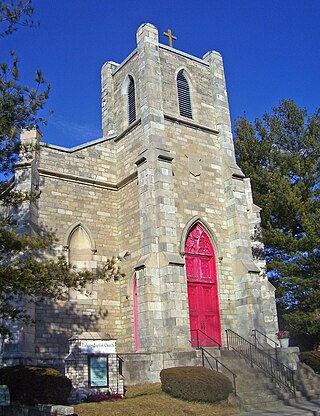
Calvary Baptist Church, originally St. Paul's Episcopal Church, is located on St. Paul's Place in Ossining, New York, United States. It is a stone building in the Gothic Revival architectural style, considered the best preserved early example of that style in Westchester County. It is also one of the few remaining Calvin Pollard buildings in the state. Built in the 1830s, it is the oldest house of worship in the village. In 1978 it and its rectory across the street were added to the National Register of Historic Places.

Episcopal Church of the Nativity is a church in Huntsville, Alabama. It was built in the Gothic Revival style in 1859. It is noted as one of the most pristine examples of Ecclesiological Gothic architecture in the South. It is also one of the least-altered structures by architect Frank Wills and one of only thirteen surviving houses of worship designed by him in the United States. It was declared a National Historic Landmark in 1990.

St. Mark's Episcopal Church, also known as St. Mark's, Capitol Hill, is a historic Episcopal church located at 3rd and A Streets, Southeast in the Capitol Hill neighborhood of Washington, D.C. Built 1888–1894, the church is an example of Gothic Revival and Romanesque Revival architectures.

Grace United Methodist Church is a historic Methodist Church building at 34 Court Street in Keene, New Hampshire. Built in 1869, it was designed by architect Shepard S. Woodcock, and is one of the largest churches in southwestern New Hampshire. It was added to the National Register of Historic Places in 1985. Its congregation moved in 2009 and was disbanded in 2016, and the building is undergoing renovation for use as professional offices.
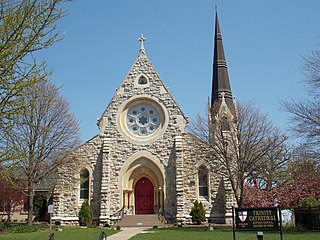
Trinity Episcopal Cathedral, formerly known as Grace Cathedral, is the historic cathedral in the Diocese of Iowa. The cathedral is located on the bluff overlooking Downtown Davenport, Iowa, United States. Completed in 1873, Trinity is one of the oldest cathedrals in the Episcopal Church in the United States. It was individually listed on the National Register of Historic Places in 1974. In 1983 the cathedral was included as a contributing property in the College Square Historic District, which is also listed on the National Register.

St. James' Episcopal Church is a Gothic Revival-styled Episcopal church built in 1867 - once a parish of the Episcopal Diocese of Milwaukee. In 1979 the building was added to the National Register of Historic Places. Today it is probably the oldest stone church remaining in Milwaukee.

The Piety Hill Historic District is a historic district located in downtown Lapeer in Lapeer County, Michigan. It was designated as a Michigan State Historic Site and also added to the National Register of Historic Places on July 26, 1985.

St. John Chrysostom Church, also known as the Episcopal Church of St. John Chrysostom and the Little Red Church on the Hill, is a wooden Episcopal church built in 1852 in Delafield, Waukesha County, Wisconsin. In 1972 it was listed on the National Register of Historic Places.

St. Mary's Roman Catholic Church is a Roman Catholic church located in Port Washington, Wisconsin. Its congregation is part of the parish of St. John XIII in the Archdiocese of Milwaukee. The church was added to the National Register of Historic Places in 1977 for its architectural and religious significance.

St. Paul's Episcopal Church is a historic parish of the Episcopal Church in Watertown, Wisconsin,. Its buildings display different phases of Gothic Revival architecture, and in 1979 the complex was added to the National Register of Historic Places for its architectural significance.

St. Paul's Episcopal Church is a Gothic Revival-styled church built 1848–51 in Beloit, Wisconsin - the oldest church in continuous service in Rock County. On April 4, 1978, it was added to the National Register of Historic Places for its architectural significance. It is affiliated with the Episcopal Diocese of Milwaukee.
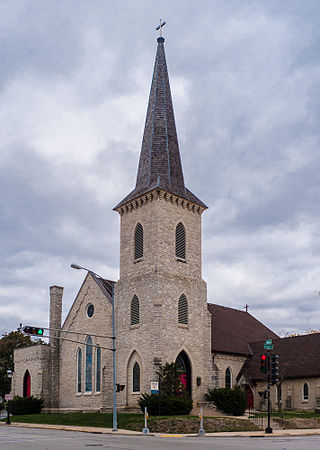
St. Matthias Episcopal Church is a Gothic Revival-styled limestone-clad church built from 1851 to 1855 in Waukesha, Wisconsin. It was built by St. Matthias parish of the Episcopal Church, now in the Diocese of Milwaukee, and is the oldest church building in Waukesha that survives basically intact.

The First Unitarian Church is a historic Gothic Revival-styled church built in 1891–92 in Milwaukee, Wisconsin. It was added to the National Register of Historic Places in 1974.

Saints Peter and Paul Roman Catholic Church Complex is located in Milwaukee, Wisconsin. The complex was added to the National Register of Historic Places in 1991 for its architectural significance.

Salem Evangelical Church is a modest Victorian Gothic church built in 1874 in Milwaukee, Wisconsin. It was added to the National Register of Historic Places in 1987 for its architectural significance, and for being "the oldest surviving church building in the near south side... associated with a German congregation."
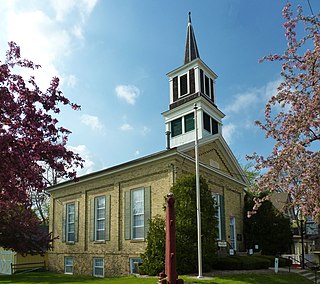
The Stoughton Universalist Church is a Greek Revival-styled church built in Stoughton, Wisconsin in 1858. It was added to the National Register of Historic Places in 1982.

The Highland Avenue Methodist Church in Milwaukee, Wisconsin is a Gothic Revival-styled church built in 1891 by Milwaukee's first German Methodist congregation. It was added to the National Register of Historic Places in 1986.
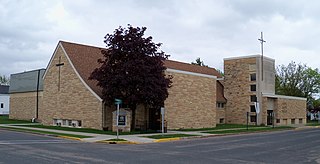
First English Lutheran Church is a historic church at 354 Third St., North in New Richmond, Wisconsin, United States. It was built in 1906 and was added to the National Register of Historic Places in 1988.
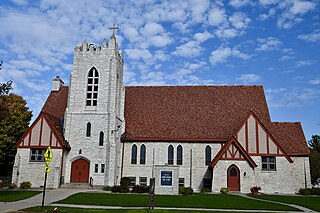
The Seventh Day Baptist Church is a Gothic Revival-style church built in 1934 in Milton, Wisconsin. It was added to the National Register of Historic Places in 2016.



























